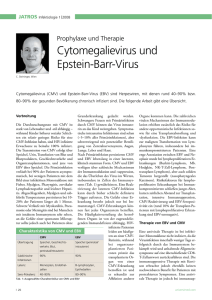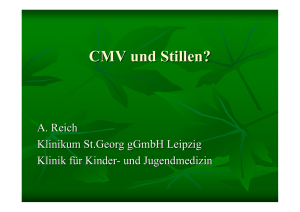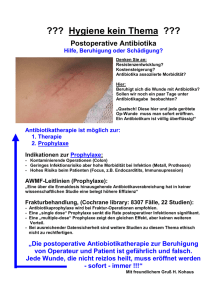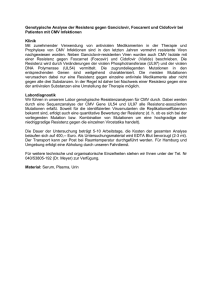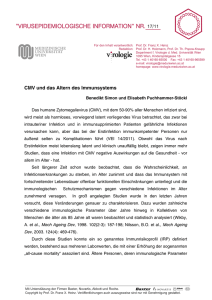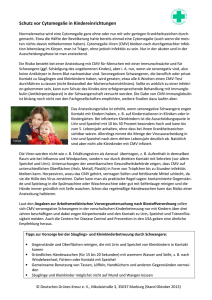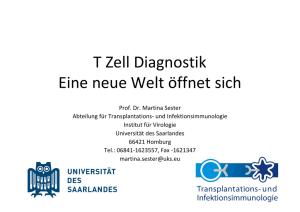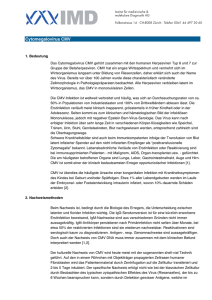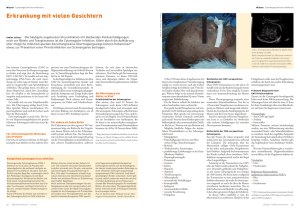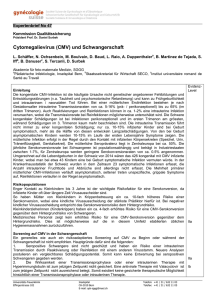CMV-Prophylaxe - Transplantationszentrum Freiburg
Werbung
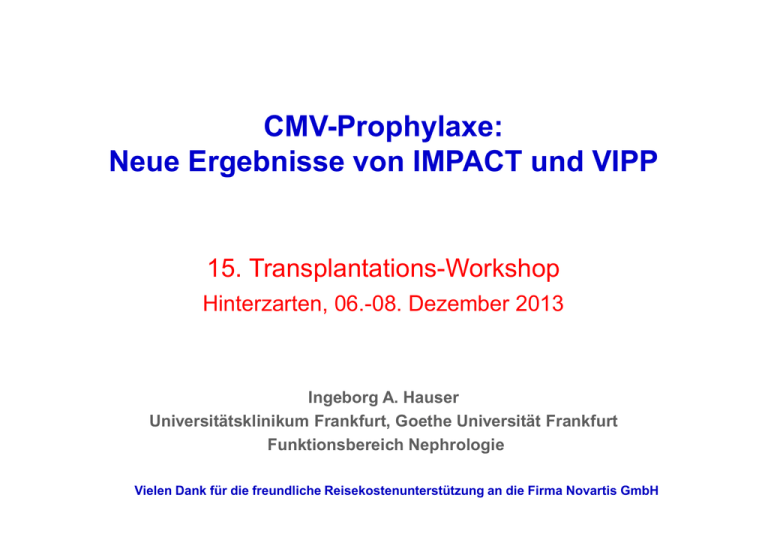
CMV-Prophylaxe: Neue Ergebnisse von IMPACT und VIPP 15. Transplantations-Workshop Hinterzarten, 06.-08. Dezember 2013 Ingeborg A. Hauser Universitätsklinikum Frankfurt, Goethe Universität Frankfurt Funktionsbereich Nephrologie Vielen Dank für die freundliche Reisekostenunterstützung an die Firma Novartis GmbH CMV-Prophylaxe • Einleitung Prophylaxe • IMPACT: D+/R- High Risk • VIPP: R+ Moderate Risk • Guidelines und Cochrane Analyse 2013 • Neue Aspekte 2013: ATC und published data Infektionsraten im 1. Jahr nach NTX 1995-2002 Snyder /Kasiske et al.: Kidney Int 2009: CMV-Infektionen sind die häufigsten Virusinfektionen nach Nierentransplantation KDTx without prophylaxis Late onset Disease Longterm phase HSV CMV EBV, VZV, HHV8 0 1 2 CMV CMV 3 4 5 Polyoma 6 7 Time after KDTx in months Modified from Fishman & Rubin, NEJM, 1998 Auftreten einer symptomatischen CMV-Infektion oder Erkrankung nach NTX und PNTX abhängig vom Serostatus ohne Prophylaxe D/R-Status CMV-Erkrankung D pos./ R neg. (n=349) 68% D pos./ R pos. (n=423) 33% D neg./ R pos. (n=279) 13% D neg./ R neg. (n=373) 4% nach B. N. Becker et al. 2002 Transplantation 39: 1088-1095 Warum treten CMV-Infektionen nach Transplantation gehäuft auf? • Primärinfektion (Serologie: D +/ R -) oder Viren können mit dem Organ übertragen werden • Latente Viren werden apparent bei T-Zell-Defizienz Abstosssung Immunsuppression Immundefizienz Infektionen und Tumore CMV- Erkrankung nach Transplantation CMV-Syndrom bzw. organinvasive Erkrankung: Klinische Symptome und Laborparameter • Fieber (CRP normal oder nur leicht erhöht) • Allgemeine Schwäche, • G-I-Beteiligung: Kolitis, Hepatitis, Pankreatitis • Interstitielle Pneumonie : Risiko der Superinfektionen • Kopfschmerzen->Encephalitis • Leukopenie, Thrombopenie CMV-Pneumonie mit Pneumocystis Superinfektion Therapie: Hydrocortisonperfusor und Pausieren aller weiteren Immunsuppressiva, spezifische antibiotische & antivirale Therapie, Entlassung mit 2-fach IS CsA/Steroide 4 Wochen später CMV-Dickdarmentzündung mit blutigen Durchfällen, hohem Fieber trotz Ganciclovir Therapie Detektion einer GCV-Resistenz bei fehlendem Ansprechen der Therapie Wirkmechanismen der anti-CMV Therapie Ganciclovir Cidofovir Foscarnet L. Naesens et al., 2001, Herpes, 7: 12-15 Diagnostik und Therapie der CMV-Infektion • Diagnostik – quantitative CMV-PCR aus peripherem Blut – alternative pp 65 antigen im Blut – Biopsie bei Kolitis • Therapie – spezifische Therapie mit Ganciclovir i.v oder Valganciclovir p.o. (adaptiert an Nierenfunktion) – Reduktion der Immunsuppression – CMV-spezifische Immunoglobuline i.v. bei Pneumonitis Updated Int. Consensus Guidelines on the management of Cytomegalovirus in Solid Organ Transplantation by CN Kotton et al., Transplantation 2013, pp333; Dosierung von Valganciclovir zur Therapie und Prophylaxe der CMV-Infektion in Abhängigkeit von der Nierenfunktion JA Fishman et al. Prophylaxestudien CMV-Erkrankung nach Transplantation verhindern durch Prävention • Prophylaxe: antivirale Medikation in halber therapeutischer Dosis (Valganciclovir) bei CMV-Risiko ohne Virusnachweis • Präemptive Therapie: antivirale Therapie bei positiver Virusreplikation, d.h. positiver CMV-PCR (>400 Kopien) ohne Krankheitssymptome; CMVPCR Screening erforderlich! CMV - Prophylaxe mit Valacyclovir: Häufigkeit und Zeit bis zum Auftreten einer CMV-Erkrankung (D+/R-) D. Lowance et al., 1999, N Engl J Med 340:1462-70 Patients with no CMV disease (%) CMV - Prophylaxe mit Valgancyclovir vs oralem Ganciclovir bei solid Organtransplantierten (D+/R-): Zeit bis zur CMV Erkrankung 100 Valganciclovir 90 80 Ganciclovir 70 60 n = 364 50 40 30 20 10 Prophylaxis Period 0 0 25 50 75 100 125 150 175 200 225 250 275 300 325 350 Time (days) (Kaplan-Meier analysis) Paya C et al. Am J Transplant 2004; 4:611-20. Vorteile der CMV Prophylaxe für die Hochrisikogruppe: Metaanalyse Hodson et al. Lancet 2005 Indirekte Effekte der CMV-Prophylaxe auf andere Infektionen und den Immunstatus JA Fishman et al. Indirekte Effekte der CMV Infektion nach solider Organtransplantation Indirect cellular effects cytokines, chemokines, Growth factors, Systemic infections, Immunomodulatory effects Vasculopathy PTDM? Increased risk of opportunistic infections Systemic Immunosuppression Transplantrejection/ - damage (acute, chronic) Malignant diseases, EBV-associated PTLD Mdified based on Kotton CN und Fishman JA, J Am Soc Nephrol 2005; 16: 1758-1774; Fishman JA, N Engl J Med 2007; 357: 2601-14; Vitko S et al. Am J Transplant 2004; 4: 626-635; Hjelmesaeth J et al., Diabetologica 2004, 47: 1550-1556; C Courivaud et al; JID 2013, A. Egli et al; CID 2012:1678 CMV-Infektionen sind die häufigsten Virusinfektionen nach Nierentransplantation KDTx without prophylaxis Late onset Disease after prophylaxis HSV CMV CMV EBV, VZV, HHV8 0 1 2 3 4 5 Polyoma 6 7 Time after KDTx in months Modified from Fishman & Rubin, NEJM, 1998 Verlängerte CMV-Prophylaxe in CMV Hochrisikopatienten IMPACT Improved Protection Against Cytomegalovirus Prophylaxe mit Valganciclovir in Hochrisikopatienten (D+/R-): 3 vs. 6 Monate Prophylaxe nach NTX IMPACT Study design VGCV 100 days Valganciclovir 900 mg qd* Placebo * dose adjusted for renal function VGCV 200 days Valganciclovir 900 mg qd* Randomisatio n 100 days Valganciclovir 900 mg qd* 200 days 1 year 2 years post transplant Transplantation 2010 Dec; 90(12): 1427-31. • Assessments up to 2 years included; – CMV disease – BPAR, patient and graft survival – CMV seroconversion (IgG or IgM) Transplantation 2010 Dec; 90(12): 1427-31. Signifikant reduzierte Inzidenz der CMV-Erkrankung unter einer VGCV-Prophylaxe von 200 Tagen Humar A et al. Am J Transplant 2010; 10:1228-37. IMPACT Trial Results: Incidence and time to onset of CMV-disease 200 days 100 days Most common AEs Overall occurence of leukopenia and neutropenia was low AE; n (%) Leukopenia Diarrhoea Peripheral oedema Urinary tract infection Anaemia Neutropenia Tremor Constipation VGC – 100 days n = 164 43 (26) 43 (26) 35 (21) 26 (16) 30 (18) 25 (15) 19 (12) 25 (15) VGC– 200 days n = 156 59 (38) 49 (31) 30 (19) 34 (22) 24 (15) 23 (15) 26 (17) 14 (9) Leukopenia led to discontinuation of Valganciclovir (VGC) in only 7 patients (4%) in the 200 days group, and 1 patient (<1%) in the 100 days group Humar A et al. Am J Transplant 2010; 10:1228-37. Ganciclovir-resistance mutations were detected at low rates in both treatment groups Known resistance mutations detected in 3 patients (4.6 - 4.9%) in each treatment group Treatment Group Gene Mutation Reduction in VGC Susceptibility VGC – 100 days UL97 M460V 8-fold UL97 C592G 3-fold UL97 C592G 3-fold UL97 M460V 8-fold UL97 C603W 8-fold UL54 P522S 3-fold VGC – 200 days Chou S et al. Transplantation 2010; 90:1409-13. 1Chou S et al. Antimicrob Agents Chemother 2005; 49:2710-15. Zusammenfassung IMPACT-STUDIE • Eine Verlängerung der Valganciclovir Prophylaxe von 100 auf 200 Tage reduziert hoch-signifikant – die Inzidenz von CMV Erkrankung – aktiver CMV Infektion – die Viruslast – <5% Resistenzentwicklung – kosteneffektiv • Nebenwirkungen auf das blutbildene System sind v.a. Leukopenien aber in bd. Gruppen nicht signifikant unterschiedlich Auftreten einer symptomatischen CMV-Infektion oder Erkrankung nach NTX und PNTX abhängig vom Serostatus ohne Prophylaxe D/R-Status CMV-Erkrankung D pos./ R neg. (n=349) 68% D pos./ R pos. (n=423) 33% D neg./ R pos. (n=279) 13% D neg./ R neg. (n=373) 4% nach B. N. Becker et al. 2002 Transplantation 39: 1088-1095 Zusätzlicher Risikofaktor sind T-zell depletierende AK VIPP Trial Valganciclovir CMV Infection Prophylaxis and Proteomics bei CMV seropositiven Patienten Ziel: CMV Infektion und Erkrankung nach 1 Jahr und 5 Jahre follow-up bzgl. NTX/Patienten Überleben VIPP trial concept II CMV IgG pos. Rec. Häufigste AE‘ ‘s nach 3 Jahren Primary prophylaxis using oral valganciclovir Preemptive therapy using oral valganciclovir p-value ITT/Safety population (N = 146) ITT/Safety population (N = 150) Urinary tract infection 57 (39.0%) 50 (33.3%) n. s. Diarrhoea 43 (29.5%) 43 (28.7%) n. s. Nasopharyngitis 36 (24.7%) 32 (21.3%) n. s. Leukopenia 40 (27.4%) 34 (22.7%) n. s. Creatinine increased 38 (26.0%) 33 (22.0%) n. s. All p-values are determined using the Fisher’s exact test Freedom from symptomatic CMV disease in D+/R+ Patients is higher in the prophylaxis group one year data (VIPP Study) Modified from Witzke et al. Transplantation 2012; 93: 61-68. Freedom from asymptomatic CMV infection is higher in the prophylactic group D+/R+ patients (VIPP Study) Modified from Witzke et al. Transplantation 2012; 93: 61-68. 3-Jahresdaten: CMV Infektion & Erkrankung Freedom from infection (% of patients) Freedom from syndrome/ disease (% of patients) P= ns p=0.003 96.4 D-/R+ 96.4 77.8 P=0.002 p<0.0001 D+/R+ 93.1 94.4 83.3 78.2 46.1 NTX-Verlust und Tod nach 3 Jahren 20 Events 15 10 graft loss death 10 4 5 8 5 p = n.s. 0 Prophylaxis Prophylaxe Preemptive Preemptiv Pts with graft loss or death (%) Transplantatverlust und Tod des Patienten bei Pat +/- CMV Infektion in beiden Gruppen 25 20,7 20 15 Pats without CMVInfection Pats with CMVInfection 10 5,4 5,9 5,4 5 0 Prophylaxis Prophylaxis (N=8) n=8 Preemptive Preemptive (N=17) p = n.s. n=17 5-Jahresdaten stehen aus (2014)! Zusammenfassung-VIPP Valganciclovir prophylaxe reduziert signifikant CMV Infektion/Erkrankung in R+ auch über 3 Jahre. Numerisch gibt es mehr TX-Verluste und Tod des Patienten in der preemptiven Gruppe und zwar bei den Patienten mit Virämie. Die 5-Jahresdaten werden zeigen, ob die Prophylaxe signifikant mit positiven LZ-Effekten assoziiert ist . Abstract A578, Manuel, O. ATC 2013 in Seattle • CMV-Prophylaxe vs. Preemptive Therapie bei 1239 Patienten der Swiss Transplant Cohort study • wenige Erkrankungen in beiden Gruppen • aber: • weniger TX-Verlust nach mehr als einem 1 Jahr in der Prophylaxegruppe Mortalität im Jahr 1 nach NTX is erhöht in R+ Patienten mit CMV Erkrankung H. Harvala et al; J Med Virol. 2013 893-898 KDIGO Guidelines 2009 AJT, Chapter 13 Viral diseases; (9 Suppl.3,S46-48, CMV) 13.2.1 CMV-Prophylaxe: Wir empfehlen, dass Nierentransplantatempfänger (ausser bei negativem Serostatus von Spender und Empfänger) eine Prophylaxe gegen CMVInfektion erhalten mit oralem Ganciclovir oder Valganciclovir für mindestens 3 Monate nach Transplantation (1B) und für 6 Wochen nach Behandlung mit einem T-Zell depletierenden Antikörper (1C) Neuere Studien überprüfen den Nutzen der verlängerten Prophylaxe IMPACT! Cochrane Analyse 2013 CMV-Prophylaxe • Weniger CMV-Erkrankung • reduzierte Gesamtmortalität • reduzierte Infektionen durch Herpesviren, Bakterien und Protozoen aber nicht Pilzen • längere Prophylaxe sinnvoll bei D+/R- (IMPACT) • Daher Prophylaxe empfohlen D+/R- und R+ Cochrane Analyse 2013: CMV-preemptive Strategie • Weniger CMV-Erkrankung • kein Einfluss auf Gesamtmortalität • keine ausreichende Studiengrundlage für den Vgl Prophylaxe vs preemptive Therapie • Daher mehr Studien erforderlich CMV-Erkrankung nach Transplantation verhindern durch Prävention • Prophylaxe: antivirale Medikation in halber therapeutischer Dosis (Valganciclovir) bei CMV-Risiko ohne Virusnachweis • Präemptive Therapie: antivirale Therapie bei positiver Virusreplikation, d.h. positiver CMV-PCR (>400 Kopien) ohne Krankheitssymptome; – (wöchentliches) CMV-PCR Screening erforderlich! Updated Int. Consensus Guidelines on the management of Cytomegalovirus in Solid Organ Transplantation by CN Kotton et al., Transplantation 2013, pp333; CMV-Infektionen sind die häufigsten Virusinfektionen nach Nierentransplantation KDTx without prophylaxis Late onset Disease Longterm phase HSV CMV EBV, VZV, HHV8 0 1 2 CMV CMV 3 4 5 Polyoma 6 7 Time after KDTx in months Modified from Fishman & Rubin, NEJM, 1998 CMV-Infektion in der LZ-nachsorge: Welche Präventionsstrategie? • Prophylaxe: antivirale Medikation bei erhöhtem CMV-Risiko post Tx ohne Virusnachweis • präemptive Therapie: antivirale Therapie bei positiver Virusreplikation (Screening), d.h. positiver CMV-PCR ohne Krankheitssymptome – – – – nach Absetzen der Prophylaxe bei Hochrisikopatienten bei intensivierter Immunsuppression, Abstossungsbehandlung bei Umstellung der Immunsuppression bei schweren Begleiterkrankungen, z.B. Sepsis, OP‘s CMV Infektion in der LZ-Nachsorge nach NTX • Bei bis zu 10% aller Patienten • significant häufiger bei Patienten mit chron. Dysfunktion • reduzierte Infektionrate unter mTor inhibitoren C Cervera et al; Transplant Infect Dis, 2011 Weniger CMV-Infektionen unter mTOR inhibitoren [F-FC293] Everolimus Significantly Reduces Cytomegalovirus Infection Incidence Versus Mycophenolate in De Novo Renal Transplant Patients: Pooled Analysis of Three Prospective Studies Daniel C. Brennan, Dharmesh Patel. Washington Univ. School of Medicine, Barnes-Jewish Hospital; Novartis Pharmaceuticals Corporation Sirolimus Transplant Infect disease 2013 Apr;15(2):150-62. Everolimus is associated with a reduced incidence of cytomegalovirus infection following de novo cardiac transplantation. Kobashigawa J, Ross H, Bara C, Delgado JF, Dengler T, Lehmkuhl HB, Wang SS, Dong G, Witte S, Junge G, Potena L. J Fortun et al; Transplant Infect. Dis 2010 Zusammenfassung • Durch Prophylaxe kann die Inzidenz, Morbidität und Mortalität durch CMV und die Gesamtmortalität signifikant gesenkt werden • bei Hochrisikopatienten ist eine Prophylaxe für 6 Monate mit VGCV empfohlen • bei moderatem Risiko (R+) Patienten erscheint eine Prophylaxe sinnvoll auch wegen der indirekten Effekte der CMV-Infektion und wird empfohlen • eine Alternative ist die preemptive Therapie unter wöchentlicher CMVPCR Kontrolle • Ganciclovir-Resistenzen sind selten aber es sollte daran gedacht werden • eine Reduktion der Inzidenz an CMV zu erkranken unter mTor Inhibitoren wurde beobachtet • Auch in der LZ-Nachsorge ist eine CMV -Reaktivierung möglich z. B. bei Sepsis und insbesonderer renaler Dysfunktion Zukunftsperspektiven – Langzeiteffekte der Prophylaxe vs Pre-emptive Therapie auf Überleben, TX-Verlust? – Prädiktoren, die eine CMV-Erkrankung bei R+ Patienten anzeigen? – Studien zur CMV-Infektion im LZ-Verlauf – Neue Medikamente oder Adaptation der Immunsuppression zur Prophylaxe für Patienten mit Leukopenie unter VGC? – CMV Impfung? Danke den IMPACT und VIPP-Studienzentren und Ihnen für Ihre Aufmerksamkeit
